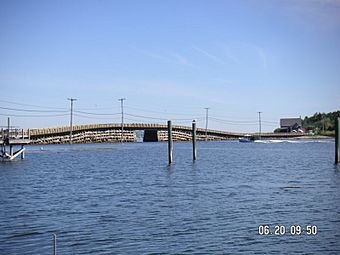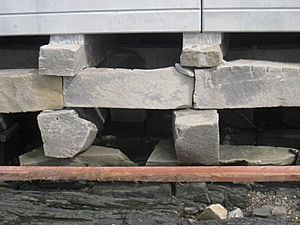Bailey Island Bridge facts for kids
Quick facts for kids |
|
|
Bailey Island Cobwork Bridge
|
|

Bailey Island Bridge from Bailey Island, looking toward Orr's Island
|
|
| Nearest city | Harpswell, ME |
|---|---|
| NRHP reference No. | 75000093 |
| Added to NRHP | April 28, 1975 |
The Bailey Island Bridge (also called the Cribstone Bridge) is a special old bridge in Harpswell, Maine. It connects Bailey Island to Orr's Island. This bridge is famous because of how it was built.
Contents
Building the Bailey Island Bridge
For a long time, people on Bailey Island really wanted a bridge. They wanted to connect their island to Orr's Island. The town of Harpswell, Maine first said no. But then, a new law helped the state pay for bridges. So, a plan for the bridge finally came together.
Work on the Bailey Island Bridge started in 1927. It was finished in 1928. A smart engineer named Llewelyn N. Edwards designed it.
How the Bridge Was Built
The bridge is about 1,150-foot-long (350 m). Building it was tricky because of the strong tides in an area called Will's Gut. Engineers decided to build a "cobwork" bridge. This means they used many large granite slabs. These slabs were like giant building blocks. They came from nearby quarries in Yarmouth, Maine.
The granite slabs were stacked together. This design lets the ocean tides flow in and out easily. It stops the water from rushing too fast. About 10,000 tons of granite were used for the project. A concrete road was built on top of these granite blocks. This road is now part of Route 24.
Important Milestones and Repairs
Over the years, some parts were added to the bridge. A sidewalk was put in for people to walk on in 1951. Guard rails were added in 1961 to keep people safe.
The Bailey Island Bridge was added to the National Register of Historic Places in 1975. This means it's a very important historic site. In 1984, it was also named a Historic Civil Engineering Landmark. This shows it's a great example of engineering. People say it's the only granite cribstone bridge in the world!
In 2009 and 2010, the bridge needed some repairs. Some of the old stones were cracked. Workers fixed the bridge carefully. They even used new stones from the same quarry in Yarmouth. This kept the bridge looking just like the original. A temporary bridge was built next to it during repairs. This allowed cars to keep driving. The bridge officially reopened in November 2010.
Images for kids








